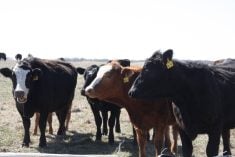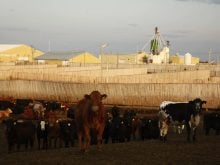Fed cattle volatility
Fed cattle prices have exhibited considerable volatility in this quarter. From the beginning of January to mid-March, prices had dropped $22 per hundredweight, but unexpected demand due to the COVID-19 virus has encouraged consumers to buy more beef. Fed prices rebounded $17 per cwt. in two weeks. Cattle that were being held back moved this week in response to improved bids.
Packers have ramped up production, taking on Saturday shifts, and profitability has been strong. Western Canadian slaughter for the week ending March 21 was 46,330 head, the largest kill since last fall.
Read Also

Flax sector sees omega-3 opportunity
SASKATOON — A global shortage of omega-3 oils could be an opportunity for the flax sector, says an industry official….
This week, dressed sales were $260-265 per cwt. delivered. Live steer prices in Alberta averaged $158.56, while Ontario lagged behind at $138.46 per cwt.
Alberta fed prices have been $11 per cwt. below the Nebraska market. No negotiated cash prices with the United States were reported this week, but some western Canadian cattle were committed to the U.S. on a formula arrangement.
Packer interest was poor in Ontario, and the market was disappointing compared to other regions.
Average carcass weights for steers hover around 914 pounds, but heifers move up or down by 10 lb. This week they averaged 853 lb. but were 862 lb. last week.
U.S. fed trade took a jump last week as packers increased production.
Dressed trade in the north was around $190 per cwt., about $15 higher than last week. Calf and feeder sales are also stronger at $5 to $15 per cwt. higher.
Feed grains
Lethbridge corn was $257.50 per tonne compared to Ontario at $203.13 per tonne.
Lethbridge barley ranged from $220-233 per tonne. Feed wheat is around the same price.
Western feeders
Auction volumes were light this week. Alberta markets sold about half their normal offering.
Calf and feeder prices rebounded this week at $10-$15 per cwt. but the week before they were down $10-$20 per cwt. Seasonally feeders are approaching their spring lows at this time and calves should start to improve.
All weight classes for feeders and stockers across the country showed improved prices.
Calves in the 500-600 lb. ranged averaged $214.50 in British Columbia. The same category in Alberta averaged $222.92 and Saskatchewan was $223.10. Manitoba was $220.20 and Ontario averaged $215.82.
Feedlots continue to see big losses, and when combined with cattle futures continuing to price in negative demand scenarios due to the market situation, may place feeders under pressure next week.
Slaughter cows and bulls
Slaughter cow prices firmed higher this week on a seasonally modest offering. Strong trim and grind demand continued to support cow prices, which rallied $7.74 per cwt. on D1 cows. D2 cows improved by $5.36 per cwt.
In the West, D2 cows averaged $92.57 per cwt. and D3 cows averaged $80.21. Ontario was behind with D2 cows averaging $86.59 per cwt. and D3 at $71.94 per cwt.
Beef trade
U.S. cut-out values firmed modestly higher this week with strong demand for grinding meat. Good demand for primal cuts was also noted. Chuck primals were $14.50 per cwt. higher than last week, and the round primal went up $8-$9 per cwt. Middle meat demand softened by $10 per cwt. on most cuts, mostly because of fewer food service orders.
U.S. Choice cut-out prices moved $208-$275 per cwt. in a week due to high demand as consumers bought up more beef to cook at home.
Boxed beef movement slipped 34 percent lower this week to 778 loads from last week’s total of 1,180 loads. Retail shelves are restocking and demand might soften next week. Cut-out values may also soften.
Canadian packers are working six days a week to hit one of the highest beef demand levels in several years.
Pork is also gaining more retail demand, and packers are ramping up production.
Ontario hogs averaged $1.697 per kilogram, up slightly from last week at $1.616.
Alberta hogs were $1.58 6 per kg, up from last week’s average of $1.435.














